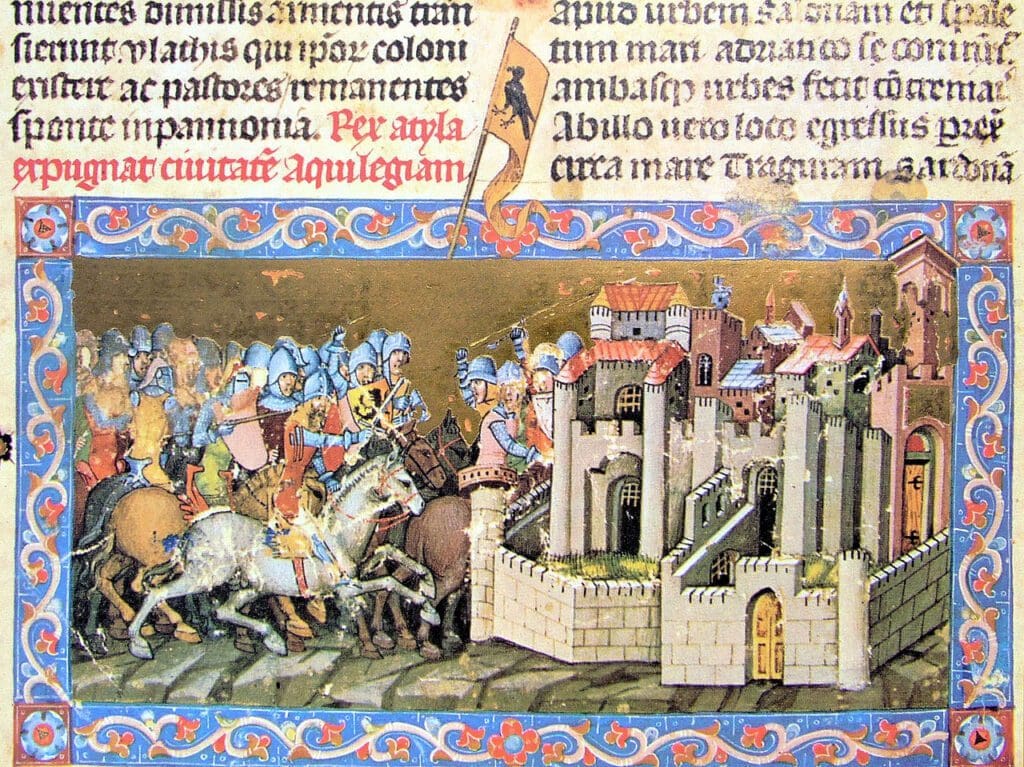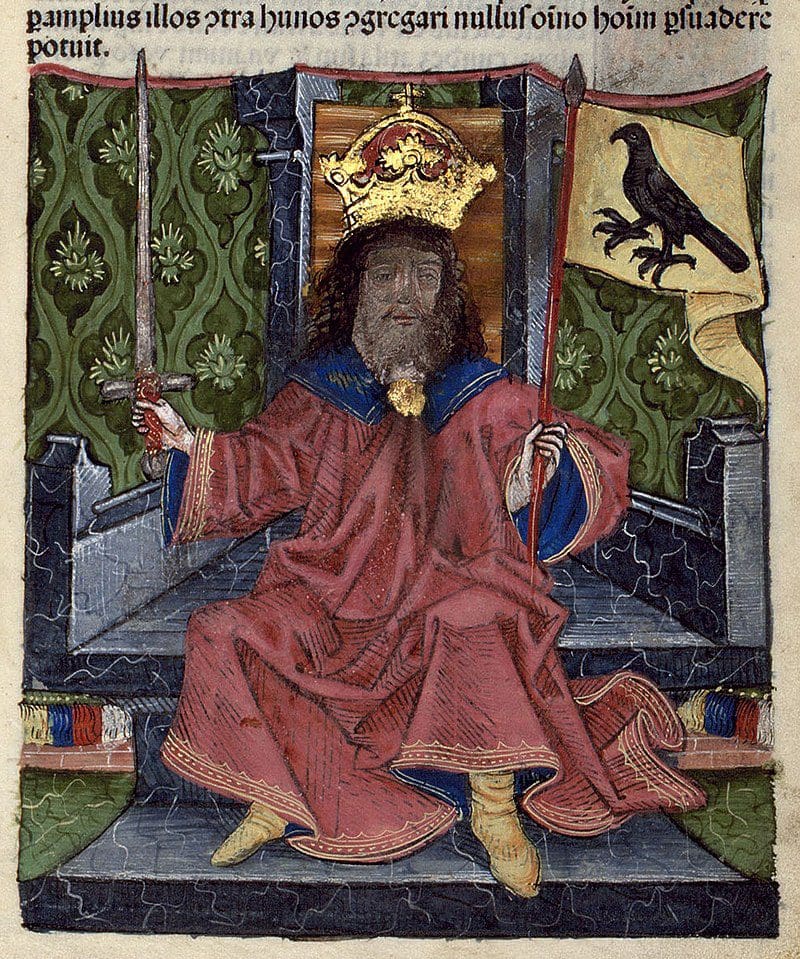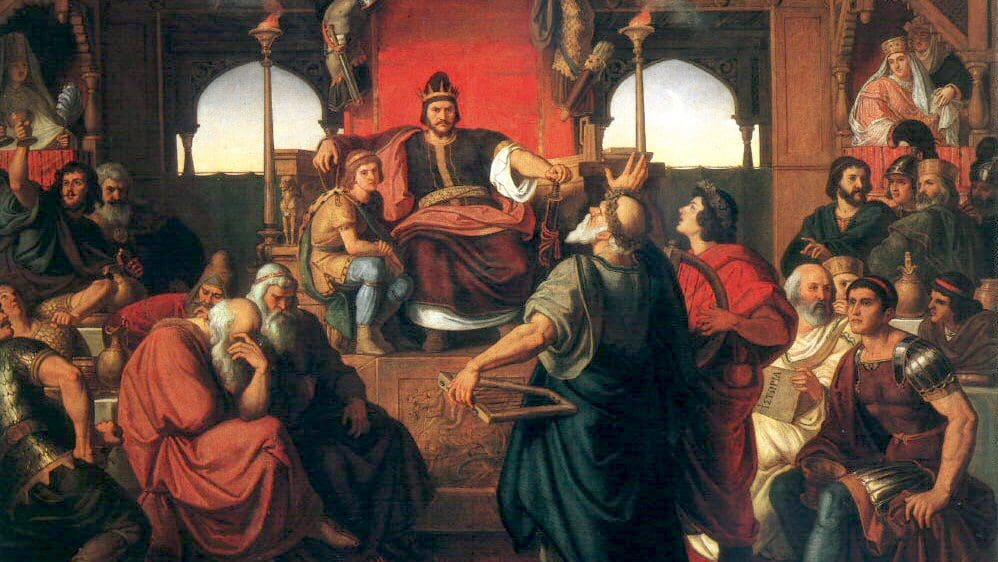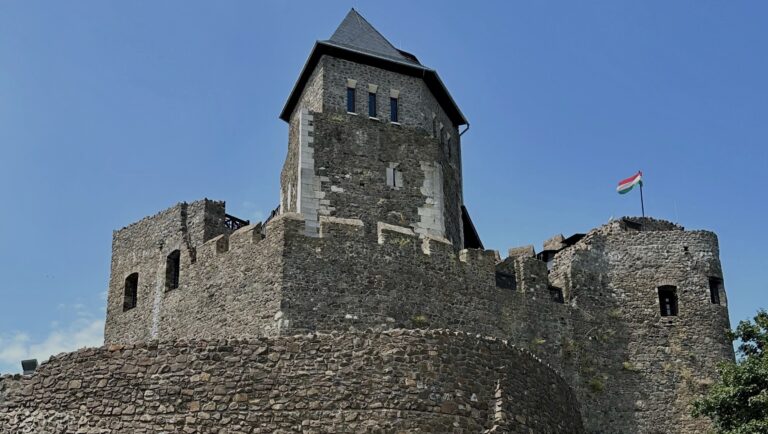Hungary is a country where, even a decade or two ago, hundreds of children were named Attila every year, and some even received the sacrament of baptism. It was the name of a dreaded Hun king who made his mark in European history with his cruel campaigns and who in later centuries was at best referred to as the ‘dog-headed man’ or, thanks to his beard and horns, the ‘devil’. From Orléans to Reims and Cologne, the clerics who opposed him even earned the glory of canonisation. In contrast, Miklós Zrínyi, an outstanding general and poet who created Hungarian military literature in the 17th century, portrays Attila as a successful general and ruler in his works to his disparate contemporaries. He emphasises that, unlike Alexander the Great, Attila ‘created a permanent and eternal kingdom for the Hungarians’, which his later descendants only had to continue.
The emergence and continuing influence of the Hunnish–Magyar kinship and identity system is a fact, but the origins of this system are still a matter of debate among scholars and the public in Hungary. A large number of non-experts are firmly convinced that this identity has a historical basis, and the events must have taken place roughly the way they appear in the works of Hungarian chroniclers. The latter assumption also implies that
the implicit acceptance of the Hunnish–Magyar tradition would put an end to the daily political ‘who got here first’ debate in the Carpathian Basin.
However, many researchers, both at home and in emigration, simply suspect the Hungarian Academy of Sciences of deliberately falsifying history in the background of the criticism of the tradition.
Scholars are much more sceptical: most of them are rather dismissive and consider the tradition to be an adoption from Western Latin literature. What is certain is, however, that medieval Hungarian chroniclers had no written sources from ancient Hungary regarding the Hunnish–Magyar tradition. Thus, the basic source of their knowledge was the Western literary tradition, even if it cannot be ruled out that the memory of Attila may have also been mentioned in historical songs of the period, which have since been lost.[1] Indeed, it is a good question to ask what, in the more than six centuries between the creation of the earliest Hungarian chronicles of 1100–1200 AD and Attila the Hun’s death in 453 AD, might have been remembered of Attila’s almost entirely disintegrated empire. The archaeogenetic studies currently being carried out on the presumed Hunnish tombs may in a few years’ time provide us with more information about the Hunnish population.[2]

The first written records of the Hunnish tradition in Hungary can be found in the chronicles of the anonymous Hungarian author, known in Latin as Anonymus, from around 1200. In his work, he mentions the name of Attila twenty-three times, stating that it was Attila, the ancestor of the Hungarian royal dynasty, who took possession of the country against the Romans. Anonymus dates the Huns’ entry into Pannonia, suggestively, to 451 (the year of the Battle of the Catalaunian Plains between the Huns and the Romans), and also mentions that the Germans called the castle of Buda ‘Etzilburg’, i.e., ‘the city of Attila’ (Etzel in German). Thus, he was certainly aware of the Germans’ knowledge of the Huns. It is perhaps no coincidence that The Song of the Nibelungs (Nibelungenlied in German) took its final form around 1200 in southern Germany, where Attila’s kingdom was identified with the territory of Hungary at the time. In it, several Hungarian cities were mentioned as parts of Attila’s kingdom, including the cities of Buda and Esztergom.[3]
According to those arguing for the ancient tradition, the place name ‘Attila’ existed in Hungary already before 1200, and it appears as a personal name in a 13th-century legal source, too. However, it is difficult to prove the depth of the tradition behind a name, or whether there was any tradition attached to the name of Attila at all. Nevertheless, an even more interesting case is the so-called ‘Attila’s Sword’, mentioned in a German chronicle from around 1070.[4] In 1063, the widow of King Andrew I of Hungary presented the Duke of Bavaria with a weapon as Attila’s sword, which is still on display in the Imperial Treasury in Vienna today. The weapon is a 10th-century Hungarian sabre, which was later most probably included among the German crown jewels and referred to as the sword of Charlemagne.[5]
Maybe it is no coincidence either that the Bishop of Bamberg, who was staying in Hungary at the time, was recorded by the German army as being preoccupied only with the figure of Attila instead of the works of St Augustine and St Gregory the Great. It was well known among the Germans that
the Hunnish Empire, which was then already referred to as the Hungarian Empire, lay in the territory of today’s Hungary.
Another German chronicler describes the treasures brought to Prague by the daughter of King Béla IV of Hungary as having been collected since the time of Attila the Hungarian King.
The complete and final elaboration of the Hunnish–Magyar identity can be found in the chronicle of the 13th-century chronicler Simon of Kéza, court clergyman to King Ladislaus IV of Hungary (r. 1272–1290), written between 1282–85[6], and based on the local historical and literary traditions (Nibelungenlied, Jordanes’ chronicle, etc.) that the author had learned from studying Roman ruins in Hungary and his travels abroad. Simon of Kéza’s decisive thesis is that there were two Hungarian conquests in the Carpathian Basin, only the first of which was by the Huns. In his chronicle, he portrays his lord, King Ladislaus IV, as a significant Christian ruler in Hungarian history, comparable only to the pagan Attila the Hun—he suggests that Ladislaus IV stands out among Christian rulers just as Attila stands out among pagans.

The text written by Simon of Kéza has been little changed by posterity. In this form, it was included in the 14th-century Illuminated Chronicle (Chronicon Pictum), the 15th-century Thuróczy Chronicle, and the Tripartitum[7], which served as the handbook of the rights of the Hungarian nobility. In the latter, the Hunnish history serves as a framework for narrating and justifying the emergence of social inequalities, which then remained the basis for the justification of the rights of the nobility in Hungarian law until the 19th century.[8]
On the other hand, Attila’s burial has also captured the imagination of medieval chroniclers—archaeologists are still trying to find his tomb, mostly in present-day Hungary.[9] Jordanes, a 6th-century chronicler whose work is fundamental to the Middle Ages, describes in detail that the great king was buried in a coffin of ore, gold, silver, and iron, but remains silent on other details. Despite the fact that the tradition of burying Attila in a Hungarian river, namely the Tisza, probably originates from the 19th century, the tradition itself has its roots in the Middle Ages. According to the 12th-century German-language Imperial Chronicle (Kaiserchronik), he was buried in Buda, while according to the 13th-century Saxon World Chronicle (Sächsische Weltchronik), he was buried in the riverbed.[10]
The idea of Attila’s Hungarian kingdom showed incredible resistance to the criticism of later approaches
and became a defining element of the Hungarian noble national image. During the Protestant period, the Huns were viewed with hostility for a long time, as they were seen as the forerunners of the Ottomans. Yet in 1621, Albert Szenci Molnár, a Protestant scholar, described Attila as the founder of the everlasting Hungarian military virtue, a patriot, and the glory to the world, just as the Catholic Counter-Reformation of the 17th century did not result in the tradition’s withering away. Attila, along with several other Hun chieftains, had a place in the line of Hungarian princes before the year 1000, until the birth of modern historiography.
Those who see the development of book printing and the appearance of Hungarian translations as the factors that made it possible for the chronicles to reach the widest sections of society are most probably right. The Buda Chronicle (1473), the first printed book in Hungary by 15th-century printer Andreas Hess; the two editions of the Thuróczy Chronicle (1488), which literally eternalised medieval Hungarian chronicle literature; Bonfini’s chronicle (1543) and the various editions of the Tripartitum (1517), which defined early modern Hungarian historical literature; as well as the Hungarian translations of these editions, are indeed milestones in this respect.
If we would like to briefly summarise the ideas of the Hunnish–Magyar identity theory, we must refer to a phenomenon that is by no means unprecedented in Hungarian history: in historically anachronistic ideas and ideals, a positive and forward-looking system of arguments and a point of reference in times of crisis in national existence could be found, and a ‘nation-preserving ideology’ could also be formed from them. This period came to an end sometime after the political consolidation following 1867, with the emergence of professional domestic historiography and scientific institutions at the end of the century. It is true, though, that the most influential Hunnish–Magyar works of fiction and fine art were produced belatedly, only in the second half of the 19th century, thanks to great Hungarian poet János Arany (d. 1882), and famous Hungarian painters Mór Than (d. 1899) and Károly Lotz (d. 1904).
What is extraordinary about the image of Attila as a ‘Hungarian King’ is not that it has evolved—the most diverse heroes of antiquity appear in similar origin myths of other peoples as well (such as Alexander the Great, Aeneas, Caesar, or Brutus)—, but rather that it has expanded into a system of arguments with daily political impact, and although it has undergone significant changes, it has survived the 21st century.
[1] András Róna-Tas, ‘Historical Traditions, Attila and the Hunnish-Magyar Kinship’, Hungarians and Europe in the Early Middle Ages: An Introduction to Early Hungarian History, Budapest, 1999, p. 425.
[2] The genetic origin of Huns, Avars, and conquering Hungarians, Current Biology, Vol. 31, No. 13, 11 July 2022, pp. 2858–2870.e7. doi: 10.1016/j.cub.2022.04.093. Epub: 25 May 2022.
[3] István Bóna, Les Huns: le grand empire barbare d’Europe (IV e–V e siècles), Paris, 2002, German version: Das Hunnenreich, Budapest, 1991, pp. 203–206.
[4] The Annals of Lampert of Hersfeld, transl. by Ian Stuart Robinson, Manchester, 2015, p. 149.
[5] Talia Zajac, ‘Remembrance and Erasure of Objects Belonging to Rus’ Princesses in Medieval Western Sources: the Cases of Anastasia Iaroslavna’s ‘Saber of Charlemagne’ and Anna Iaroslavna’s Red Gem’, in Tracy Chapman Hamilton and Mariah Proctor-Tiffany (eds.), Moving Women, Moving Objects, 500–1500, Leiden, 2019, pp. 38–46.
[6] Simonis de Kéza, Gesta Hungarorum, László Veszprémy and Frank Schaer (eds.), Budapest–New York, 1999.
[7] Online Decreta Regni Mediaevalis Hungariae. The Laws of the Medieval Kingdom of Hungary, János M. Bak (ed.), 2019, pp. 1379–1381. https://digitalcommons.usu.edu/lib_mono/4, accessed on 15 June 2023.
[8] Gábor Klaniczay, ‘The Myth of Scythian Origin and the Cult of Attila in the Nineteenth Century’, in Gábor Klaniczay, Werner Michael, and Ottó Gecser (eds.), Multiple Antiquities — Multiple Modernities: Ancient Histories in Nineteenth-Century European Cultures, New York–Frankfurt am Main, 2011, pp. 185–212.
[9] Gabriella M. Lezsák, ‘The Grave of Attila and its River-bed Burial Motif”, in Attila Mátéffy and György Szabados (eds.), Shamanhood and Mythology. Archaic Techniques of Ecstasy and Current Techniques of Research: Honour of Mihály Hoppál, celebrating his 75th Birthday, Budapest, 2017, pp. 281–294.
[10] Jennifer Williams, Etzel der rîche, Frankfurt, 1981, pp. 253–260.
Related articles:








